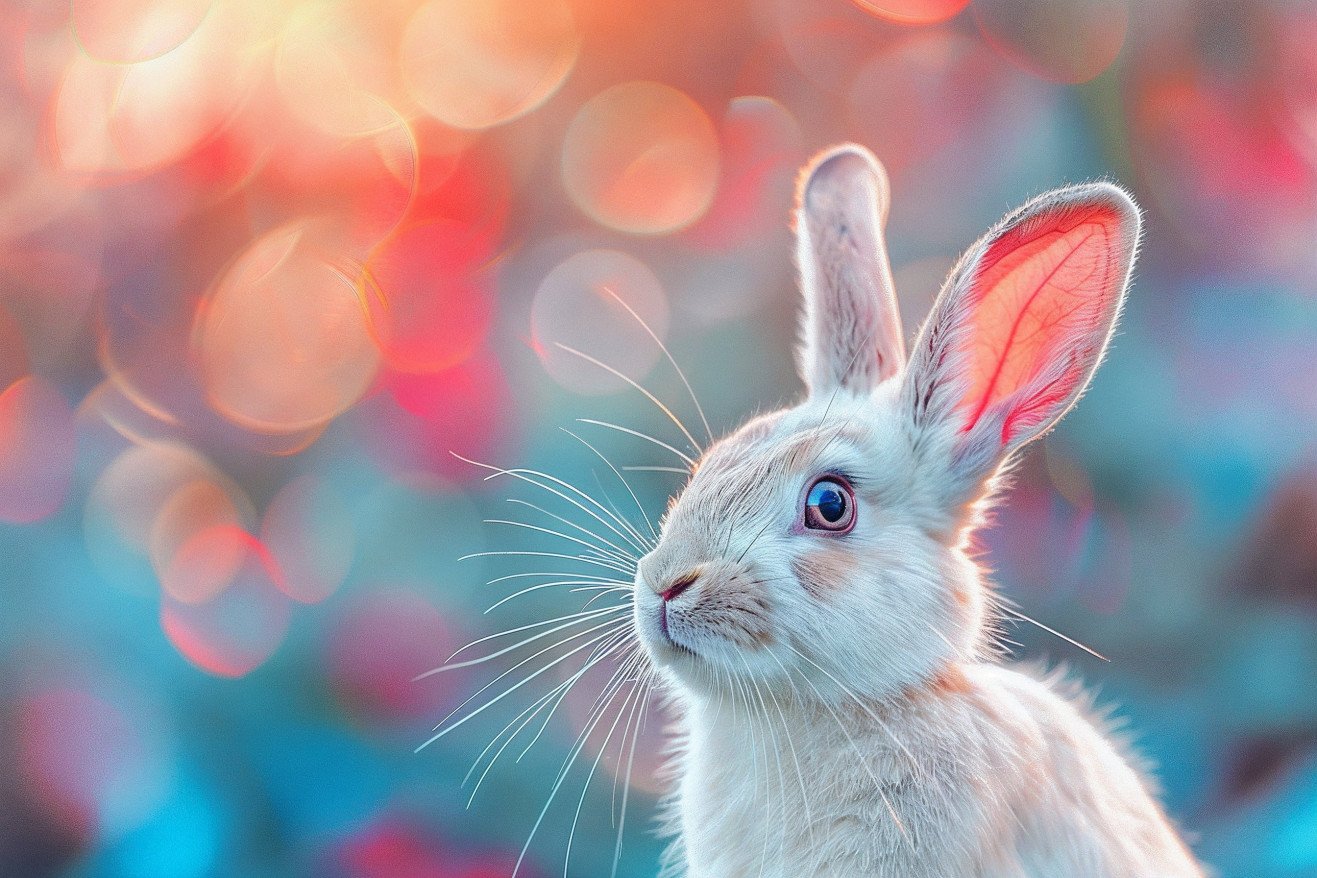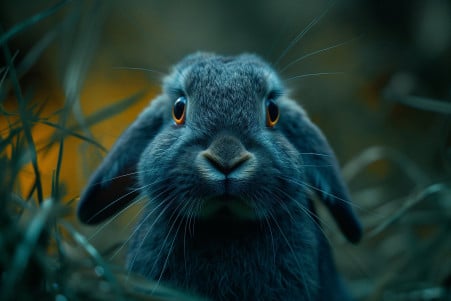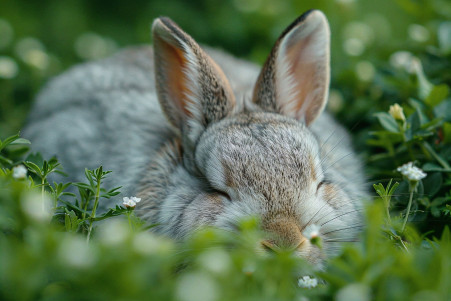The Rainbow of Rabbit Vision: What Colors Can Rabbits See?
31 May 2024 • Updated 29 May 2024

Although rabbits are often thought of as simple animals, their color vision is actually quite interesting and more complex than the black and white vision they are often associated with. Rabbits can see certain colors in the blue and green range of the light spectrum, which means they can see colors like blue, purple, blue-green, and yellow.
In this article, we will look at a number of scientific studies that have investigated the color vision of rabbits. These studies come from a variety of fields, including biology, optics, and animal behavior. Together, these different perspectives will provide a complete picture of rabbit vision and the colors they can see. So, prepare to be surprised as we uncover the colorful world that rabbits live in.
What colors can rabbits see?
Rabbits' Dichromatic Vision
The dichromatic vision of rabbits, which allows them to see blue and green wavelengths, is an incredible evolutionary adaptation that has helped them survive as prey animals. This special way of seeing color helps rabbits better spot predators against the green background of the plants in their natural habitats, as shown in a study that looked at the European wild rabbit's success in the Iberian Peninsula.
Although the absence of red cones may seem like a limitation, it may be an evolutionary compromise that helps rabbits survive in their typical habitats, where the ability to see red isn't as important. As McGill University explains, rabbits' dichromatic vision works in conjunction with their other senses, like their excellent hearing and sense of smell, to create a well-rounded system for detecting and escaping danger.
This special way of seeing, along with their other senses, has helped rabbit species thrive in a variety of environments. From the Mediterranean climate, which is hot and dry in the summer, to the constantly changing environments that humans have created, rabbits have shown that they can survive and even thrive, sometimes even using human-made structures like roads and railroads to help them spread.
Panoramic Vision: Rabbit Eye Position and Field
Rabbits' eyes are located on the sides of their heads, which gives them a nearly 360-degree panoramic field of vision. According to CreaturesCorner.com, this enables them to see predators from almost every direction, even though they have a small blind spot directly in front of them.
Rabbits can turn their heads up to 270 degrees, which means they can almost see completely behind them, and this helps them avoid blind spots. As explained by Berry Patch Farms, their ability to detect movement and their peripheral vision are both excellent, which means they can easily see anything that might be a threat or that moves in their environment.
The way rabbits' eyes are positioned is an important adaptation that works in conjunction with their color vision to help them avoid predators. Three Little Ladies Rabbitry explains that this panoramic vision enables rabbits to be on high alert and to see potential threats from all sides, which makes it less likely that they'll be caught by a predator.
How Rabbit Vision Compares to Other Prey Animals
Rabbits, like other prey animals, have evolved visual characteristics that help them better detect and escape from predators. For example, their eyes being on the sides of their heads and their wide visual fields are typical of prey animals and help them keep a watchful eye out for danger, according to a study on the anatomy and physiology of rabbits.
However, rabbits' dichromatic vision is different from many other prey animals, which have trichromatic or even tetrachromatic vision, according to an article on the differences between human and animal eyes. Rabbits make up for their lack of color vision with a strong sense of smell, excellent hearing, and sensitive whiskers, which all interact with their vision, according to research on the senses of rabbits.
Knowing how rabbit vision compares to other prey animals can help researchers better understand their evolutionary adaptations and behaviors, which is important for conservation and land management, according to a study on the adaptive success of European wild rabbits.
The Biology of Rabbit Color Vision
According to a study from The Evergreen State College, rabbits have two types of cone cells in their retinas that are sensitive to blue and green light. However, they don’t have a third type of cone cell that’s sensitive to red light, which means they can’t tell the difference between red and green.
In addition, rabbits have a higher ratio of rod cells to cone cells than humans, which makes their vision more sensitive in low light but less sensitive to color, the Evergreen State College study explains. In addition, the rabbit retina doesn’t have the high cone density of the human fovea, which means the rabbit visual image is relatively “grainy.”
Knowing these biological facts about rabbit color vision can help explain their responses to color, as well as their likes, dislikes, and evolutionary adaptations. For example, the way rabbits perceive certain colors may make them more or less intense, which could affect how rabbits respond to their environment, according to a Medium article about rabbit color vision.
Real-World Implications and Applications
For pet owners, knowing about rabbits' color vision can help them set up a more stimulating and enriching environment for their pets. Rabbit.org suggests that blue and green toys, accessories, or other items can make a rabbit's world more interesting and engaging. On the other hand, it warns against using red or orange items, which may not be visible or easily distinguishable to rabbits.
Meanwhile, researchers can use this information to improve the design of experiments and studies that use visual stimuli. Meanwhile, the University of Miami's discussion of rabbit vision explains that understanding how rabbits see the world can help with conservation and the management of natural rabbit habitats. If we know how rabbits see the world, we can make sure that our management practices are taking their unique vision into account.
In these ways, the real-world implications of this research can help pet rabbits live more stimulating lives, improve the quality of research studies, and help protect wild rabbit populations. And in the process, we can learn to appreciate the world from a rabbit's colorful point of view.
Conclusion: The Rabbit's Colorful Perspective
Rabbits have a visual system that is both unique and fascinating and differs from that of many other animals, including humans. Their dichromatic color vision, panoramic field of view, and heightened senses all contribute to their success as prey animals. Although rabbits have a limited ability to see colors, their other visual adaptations help them detect predators, move through their environment, and stay alive.
Knowledge of rabbit vision can be used to help researchers and rabbit owners better understand these animals, and it can also be used to help create more effective experiments and to manage the habitats of wild rabbit populations.


